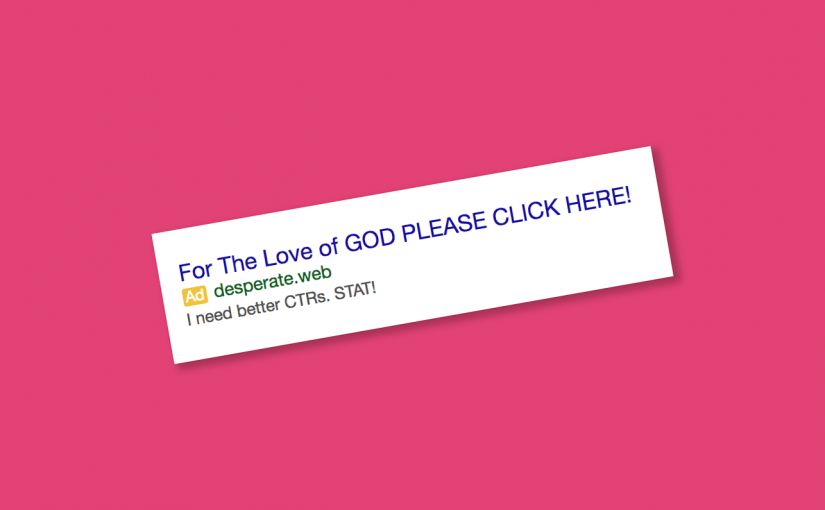“It’s only a few hundred words so it shouldn’t take you long”.
That’s a statement countless copywriting clients have thrown my way over the years. A statement that couldn’t be further from the truth.
To communicate a complex problem, sophisticated solution, or intricate product in 2000+ words isn’t too tall an order. But try to do the same in a quarter (or less) of the word count and the task becomes infinitely more difficult.
As Woodrow Wilson explained when asked how long it takes to write his speeches:
“It depends. If I am to speak ten minutes, I need a week for preparation; if fifteen minutes, three days; if half an hour, two days; if an hour, I am ready now.”
And that’s one of the main problems I see with PPC ads out there.
People put a ton of effort into creating a killer long form sales or landing page. They obsess over making the copy compelling, ensuring images complement the story, and even craft vibrant video as an accompaniment.
And then they lazily slap up a couple of ads as something of an afterthought. Ads which don’t do the landing page they’ve created justice.
Ads which are frankly uninspired, uninspiring, and just plain bad.
Writing good PPC ads is no easy feat. Trying to fit everything you want to say into what amounts to a handful of words is tough for even the most skilled writers out there.
Fortunately, there’s a couple of steps you can take with your account to speed the process along and get some killer ideas right off the bat for your testing.
[contact-form-7 id=”1206″ title=”PPC Form”]
First Consider The Structure
I’m not referring to the structure of your ads. No, character limits and the overall structure of AdWords ads are predetermined by our friends at Google.
What I am referring to is the structure of your account and how it relates to your site.
A lot of the accounts I’ve looked through all suffer from the same problem. Generic ads, with generic targeting, that link to generic landing pages.
It’s often a vain and misguided attempt to appeal to as many people as possible. But in marketing, when you try to appeal to everyone, you end up helping no-one.
Effective PPC is hyper-specific.
The best campaigns have ads that are directly related to the search a user types in. Then they serve a landing page which delivers on the promise made within the ad copy.
It’s a 3 step logical progression from a user’s query to your proposed solution.
To get that level of specificity, you’ve got to break your campaigns down by intent. Don’t make the same mistake so many others do and bundle multiple goals into single ad groups and campaigns.
Whether B2B or B2C, segment your account on intent and goal. Below I’ve applied my absolutely killer design skills to create images that give general examples for both B2B and B2C brands on how to segment their AdWords account.
First up is the general structure you should adopt when setting up a new campaign. Bear in mind that the below are focused on search network campaigns and are using the ever popular single keyword ad groups (SKAG).
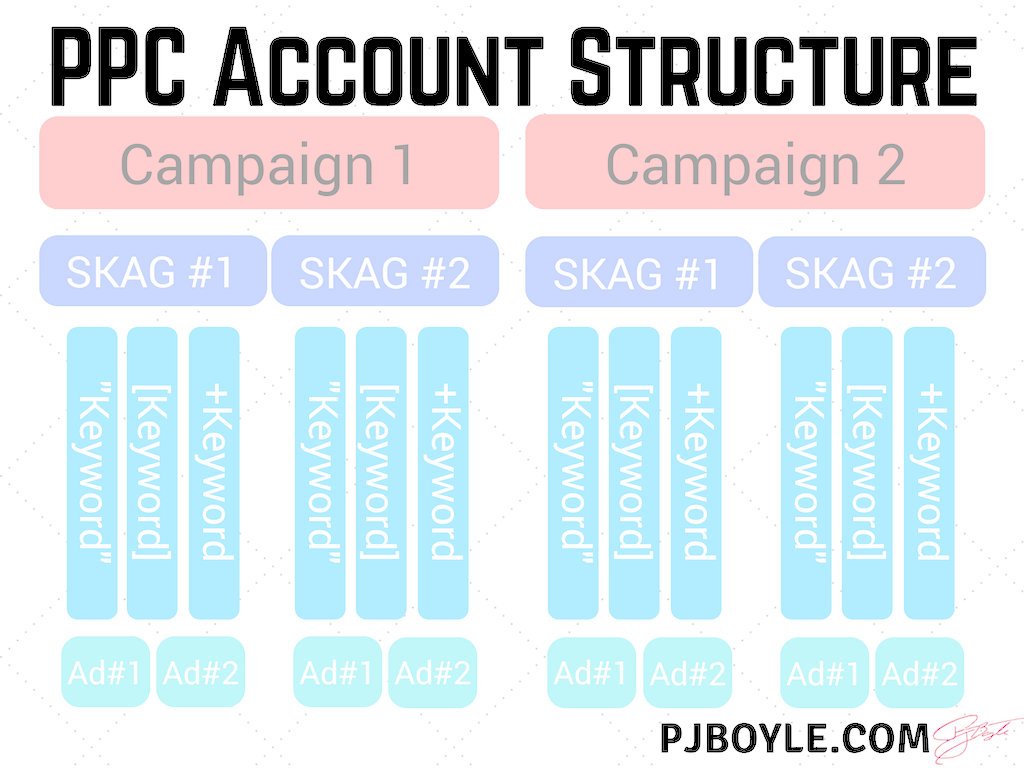
You can (and should) build out more than two SKAGs per campaign, but you want to ensure each SKAG and its corresponding ad is as relevant as possible.
Let’s break it down a little more and imagine we’re building a campaign to promote a heatmap service. Many folks would simply use different potential keywords related to heatmaps and build ads that served the user’s search term back to them.
Those keywords could include:
- {Brand name} heatmaps
- What is a heatmap?
- Heatmap guide/advice
- Heatmap service/tools/software
It’s not a bad method and will likely appease the Google Gods as the ad copy and landing page are highly related to the search term.
However, they’re still too general. Those four keywords for heatmaps are spread across the customer’s purchase journey.
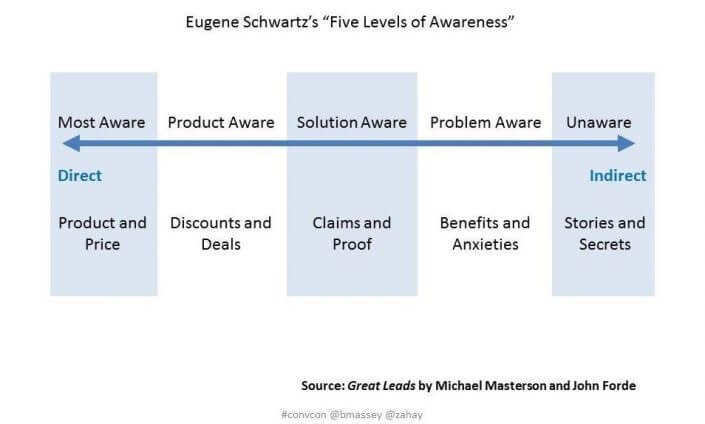
Searches for heatmap service/tools/software are from product aware people. They know what the solution to their problem is, and are researching solutions.
Heatmap guide/advice are searches from solution aware people. They know of heatmaps, but aren’t 100% sure how they can help.
What is a heatmap would be indicative of a person who is right at the beginning of the awareness cycle, and the brand name search signals someone at the end.
With SKAGs, you have to go beyond ad relevancy. You’ve got to consider what each search tells you about the user, and how you can offer the right information to progress their awareness and move them down your purchase funnel.
That’s going to affect the pages you link to and what they say. But more importantly, it’s going to affect the kind of copy you include in your actual ad.
The language that you use for someone who is comparing products is vastly different to someone who isn’t even aware of the problem or solution yet.
So let’s take a quick look at how you might market a B2B and B2C product/service at the different stages of awareness.
I’m going to work on the assumption we’re selling running shoes and heatmap services.
Awareness
These people know there’s a solution to their problem and are conducting research on it. You want to keep things a little more vague here and not get too salesy.
B2C – At this stage, these guys probably won’t have a good idea of what they want to buy. They want to see what kinds of shoes are available and probably want to spend time flicking through your catalog to see if anything jumps out at them.
Feed the search term back to the user in the headline and highlight the selection you have. Don’t push individual products yet and include a couple of eye-catching words like “free” and “best”. Here are some examples.
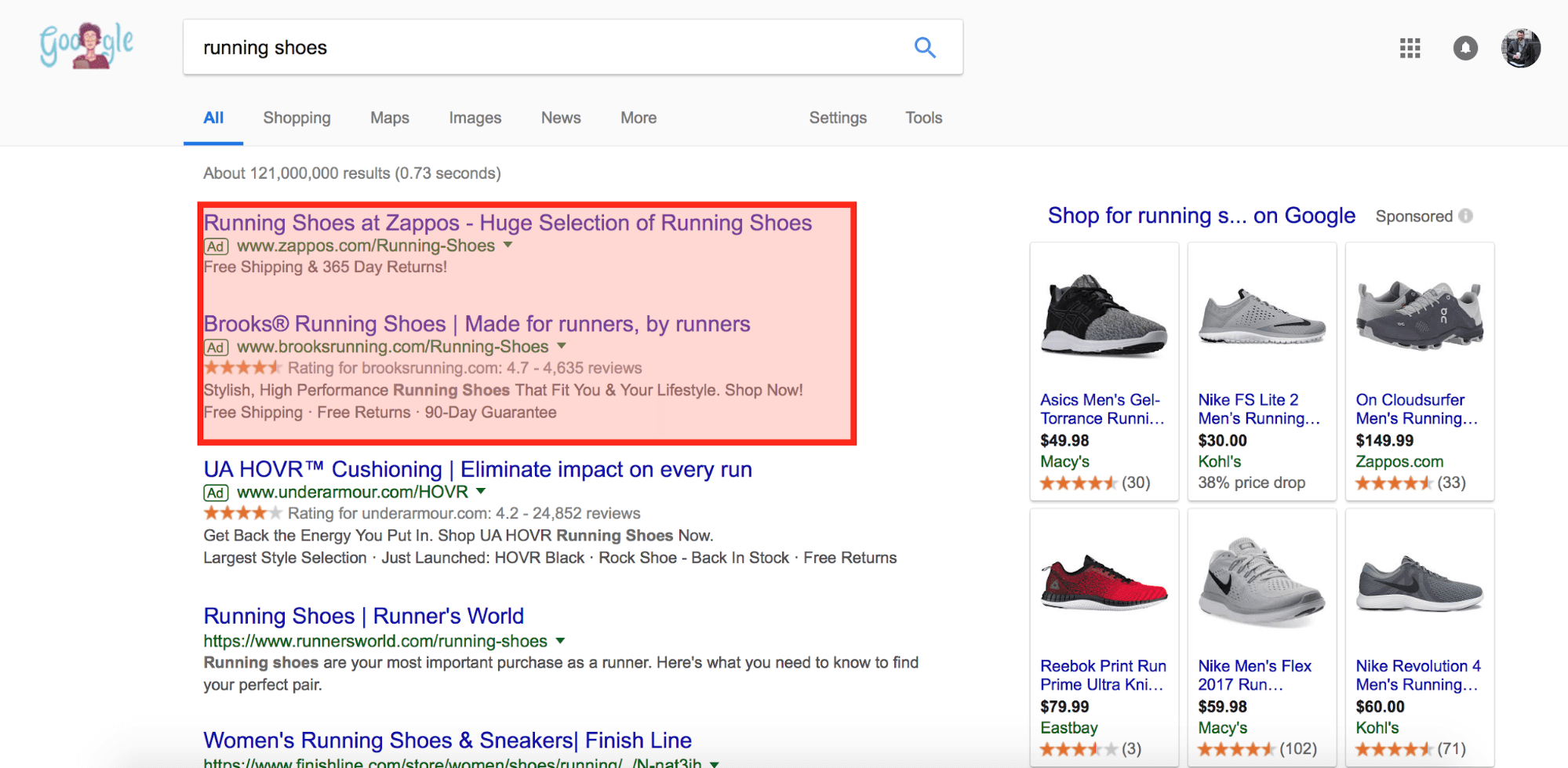
The Zappos and BrooksRunning ads appeal more to someone who is at the beginning of the purchase journey. They both return the search term to the user, are low commitment, and link to the general page for running shoes.
B2B – At this stage, people will know what a heat map is, but probably aren’t sure exactly how it can help them. You want to secure your brand in the user’s mind at this early stage by answering any questions they might have.
I’d imagine people at this stage would search for things like “Heatmap guide”, “Kinds of heatmap”, or maybe even “heatmap benefits”. I typed in “heatmap guide” and got the below. Interesting to note both ads show up at the bottom of page 1.

In my opinion, neither ad is well targeted. The language of both is off for the search term. I’m looking for a guide right, but the ads are written for people later in the purchase journey.
Both are pushing the service, but I want a guide. If I were running the account for those services, I’d change the focus: offer a free heatmap guide and make sure the ad copy explains that this is what they’ll get if they click. Collect an email and nurture from there.
At this early stage of awareness, I’d recommend linking people to general content. People are too early in the purchase journey to take any meaningful conversion actions. They’re simply looking for free advice, so offer it to them.
Consideration/Comparison
When the user knows a little about the service and is considering buying, they’re gonna want to compare a couple of service providers. They’re a step away from purchasing, but need that final reassurance this is the best product/service for them.
Focus on product/competitor keywords. These people are searching for the product, but aren’t perhaps ready to buy.
B2C – “Adidas vs Nike running shoes”, “best running shoes”, “Samba OG reviews”
Link to a page that specifically compares the products, or details your product’s specific benefits.
B2B – “Company A vs Company B”, “best heatmap service”, “[Your Company] reviews”
Link to a page that offers the information they need and include a CTA that pushes them toward a purchase.
Purchase
Ready to buy so cut the crap and get to the point!
B2C – “Buy/Purchase Adidas Samba OGs”,
B2B – “[Your Company] Demo/trial/sign up”
Link to the page with your major conversion action on. Make sure the page is optimized so that the user can easily purchase or sign up to your service.
That’s the basics of it. Of course, you’ll have to experiment with your own ads to find which words bring the best conversions at each stage of intent. Before we move on, here’s a few extra notes on the overall structure of your account.
When adding ad groups, you shouldn’t need any more than 10 for each campaign. If you’re using the very effective SKAG method outlined here by Johnathan Dane of KlientBoost, you can pretty much cover all bases and have the granularity you need with a handful of ad groups.
Within those ad groups, you’re not going to need more than 7-10 keywords. Anything else detracts from the ad’s relevancy.
And those keywords should be really closely related to one another. Make use of all match types, use broad match modifiers, and stay on top of your negative keyword list to really ensure the highest relevancy.
That relevancy is important as it helps keep ad costs down whilst increasing placement and CTR.
Understand Industry Jargon
A couple of years back there was a slew of articles decrying the use of jargon in any of your copy. And you know, I get it.
Often, brands resort to jargon to try and make their brand sound more impressive. And for B2C brands, it’s just not worth it.
Very few people will pick up a microphone because of the cardioid pickup pattern or frequency response. No, they’re picking it up because it works with their other tech and comes recommended for podcasts/music/webinars or whatever.
Ignoring jargon is a great way of selling to non-experts, which is going to be like 80% of your B2C market.
Smoked in Texas, eaten in your mouth. #brisket #meatcraft pic.twitter.com/NqlrZ3McwY
— Arby's (@Arbys) August 12, 2014
Maybe not that simple though!
But B2B is different.
You’re selling to people who only want to deal with experts. People’s who’s day in and day out is spent looking at specifications, detailed overviews, and data led reports.
When gaining the trust of experts, you too have to be seen to know what you’re doing. And that means appropriate use of industry jargon.
One of the best examples of this is in an older article by Brad McMillen on Wordstream. In the article Brad describes how he landed a client selling hydraulic cylinders. However, he quickly discovered that there were different types of cylinder, and that his client only sold one. He says:
Had I not bothered to do some research, I would have assumed “a hydraulic cylinder is a hydraulic cylinder” and not caught this wasteful spend. As a result, I made sure to add “welded” as a negative keyword and called out “tie-rod cylinders” in the ad copy to avoid the shoppers looking for welded-body cylinders, pre-qualifying clicks and saving the client some dough along the way.
Not only did figuring out the right jargon help Brad target the right people, it also stopped him from attracting those who slipped through the gaps after including it in the ad copy.
But that’s not all. Using the same language as your target helps build a relationship before you ever pick up the phone. Northwestern University ran a study on language mimicry and trust and discovered that “forms of linguistic mimicry are associated with the establishment of trust between strangers”.
It stands to reason, right? I mean, if you’re selling something technically complex, would you trust the guy/gal who didn’t know the difference between widget 1 and 2? No.
If a masseuse approached you and didn’t know their arse from their elbow, there’s no way you’d trust them to work on your back, right?
Jargon should be avoided when selling mainstream B2C products. But when you’re selling to experts as you often are in B2B, jargon it up. Find the terms that will resonate with your users and weave them into your targeting and ad copy.
Numbers and Statistics
The large majority of PPC ads only make use of words.
If you do the same, you’re consigning yourself to a future of getting lost in the crowd. At it’s simplest level, successful advertising relies upon two things.
1 – Having a killer message
2 – Getting people to see it
And to achieve that second step, you’ve got to zig when everyone else zags. you’ve got to do something a little different.
Numbers also help the user anticipate what they’re about to see. They help manage expectations and are often preferred, so why they’re not used more I’m not sure.
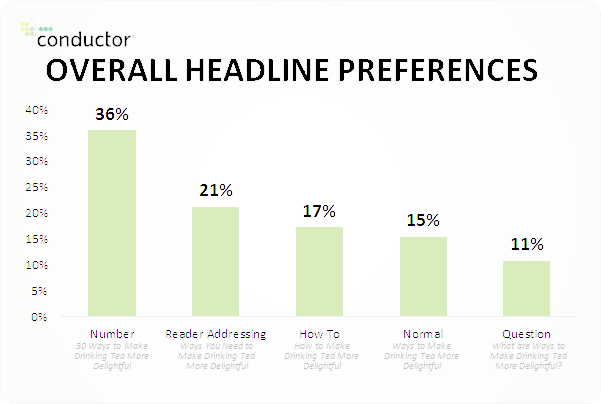
If you look through some ads you’ll notice that 9 times out of 10, your eye is drawn to those with numbers. Check out the below example.

Personally, I’d move the numbers into a slightly more prominent position. However, even with their current positioning, they stand out more than the Zoom option.
They also serve the purpose of qualifying those who click. People looking for a free solution aren’t going to click which will help keep ad spend costs down.
Use the Right Words
Certain words are simply more effective at grabbing attention.
Sex. Free. Now.
Three examples that are all but guaranteed to jump off the page. Especially when put together in a single sentence…
Thing is, not every product can be sexy, free, or delivered now. But there are certainly some words that will help your ad stand out in the SERPs.
WordStream did a great little breakdown of some of the top words that got the highest clicks across 355 ads and found that the below were the most frequently occurring words.
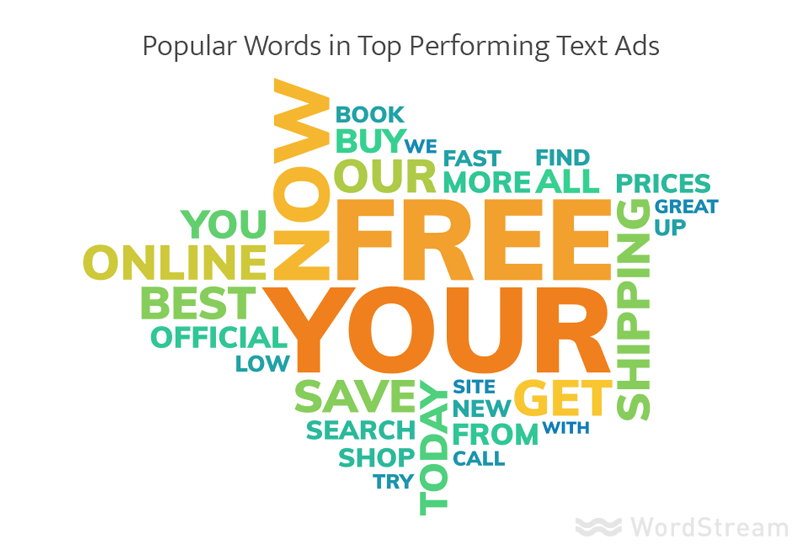
If you take a second to look through the above, you’ll notice a couple of things.
1 – There’s a couple of items related to low prices like free, save, low, and even try to an extent.
2 – One of the biggest performing words is “Your”. Hardly surprising, putting the focus on the reader is key to getting their attention.
3 – A couple of benefit heavy words like ‘get’ and ‘now’ that are associated with quick delivery.
4 – Also the mention of shipping. I’m assuming it goes with Free as, in ecommerce, free shipping (or the lack thereof) is one of the major reasons for cart abandonment.
In short, if you’re writing your text ads remember to use words that focus on the user, detail the low low price, and feature how quickly the product/service will be delivered/start producing benefits.
What You Can Never Forget
We can sit here and discuss hypothetical methods to drive more clicks through your ads, but really, there’s only one way you’re going to figure out what works.
Thorough testing and optimization.
But here’s the thing; a huge number of the accounts I’ve seen have been optimized to increase CTR of the ads and account.
And sure, that’s great. I mean, you get more people to your website which, in theory, increases the chances of making a sale. But it’s a poor way to gamble your ad spend.
If you want to succeed with PPC, you have to optimize for conversion. It’s not about the raw numbers of people you’re reaching or driving to your store, it’s about how many $$$ it takes for you to make a sale.
And optimizing for that might mean that you have to go against your better judgment. You might have to reduce the traffic you’re driving to see a higher number of overall sales.

